Planning Agenda: 2023-10-26
UPDATE 2023-10-27: Due to the length of the meeting the discussion of the potential zoning reforms was postponed. What that means for any possibility of reforms which could assist the 2024 building season is not yet known.
UPDATE 2023-11-01: The discussion of the potential zoning reforms was moved from the end of this meeting to the beginning of 👉the 2023-11-09 meeting👈.
The Planning Commission's agenda for 2023-10-26 is 👉here👈.
834 East Fulton St
The existing use of this property is a [currently] twelve (12) bay automotive repair facility which has been in operation since 1975. This request is a Special Land Use to expand the structure by another two bays, this requires moving the sites fencing from within the landscape buffer up to the property line. As this facility is in a Traditional Business Area (TBA) the use - automotive repair - itself is under Special Land Use. The property itself has a long history of zoning related changes. In 2012 the property was rezoned from Single Family Residential (LDR) to TBA by the City Commission in order to allow the expansion of the surface parking lot. Then in 2013 the Planning Commission permitted a ~2,000sq/ft expansion including four (4) new service bays; this achieved the current 12 up from the eight (8) which existed when the current Zoning Ordinance was adopted. The adoption of the current Zoning Ordinance made this property "non-conforming" - this means a preexisting use or building footprint which does not match something specified by the a newer Zoning Ordinance. It layman's terms the auto-repair facility is grandfathered.
A fourteen (14) bay auto repair facility with an office has a parking requirement of 61 spaces. The site, after expansion, would provide only 48. The applicant's parking management plan leverages two adjacent lots: 900 E Fulton for two (2) spaces and 833 Lake Dr for fifteen (15) spaces. Both of these off-site lots also have active businesses; a hair salon and a gallery, respectively. Does this satisfy the deficiency of 13 on-site spaces? The Planning Commission will decide.
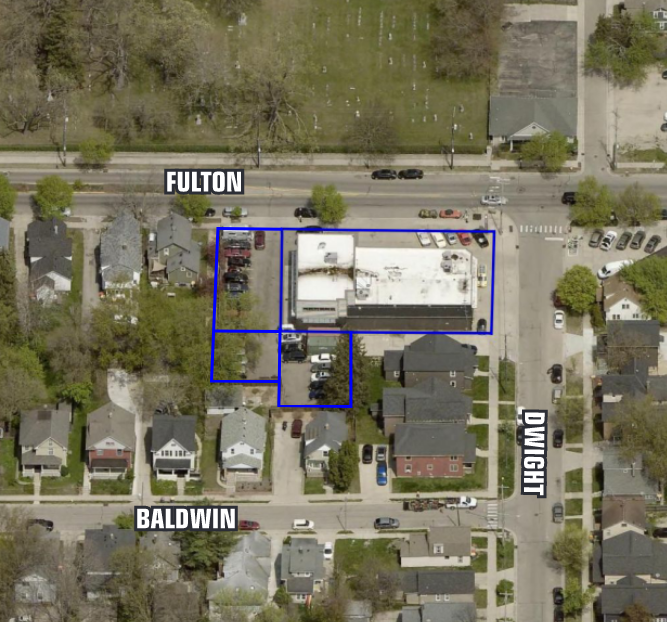 |
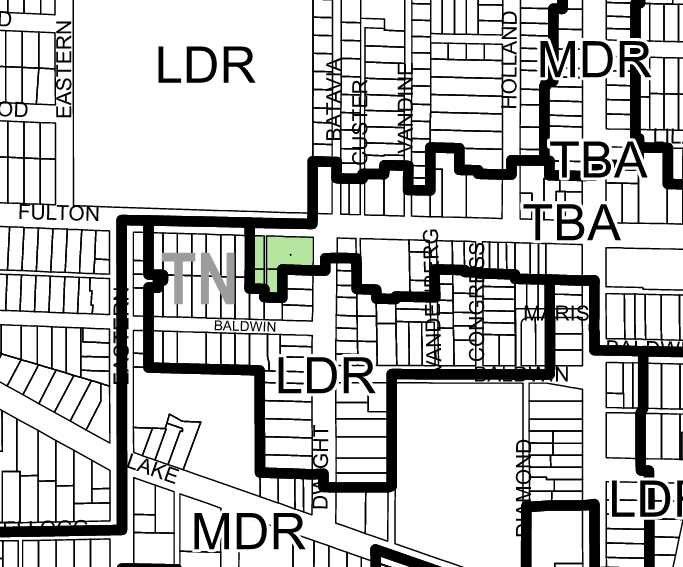 |
Corewell Health's petition to demolish Monroe North for Surface Parking
Corewell's new corporate campus in Monroe North has completed it's phase#1, which included 900 parking spaces and demolished an actively used industrial site, is wrapping up. Employees are being given tours of their new offices. BTW, reviews are glowing. It is by all accounts a very nice space. Corewelll is now onto their phase#2. Their phase#2 is entirely new surface parking lots. Again, demolishing occupied buildings to do it. Or, buildings Corewell has rendered vacant after purchasing them.
The proposal is to clear and pave five parcels: 648 Bond NW, 637 Ottawa NW, 647 Ottawa NW, 700 Ottawa NW, and 711 Ionia NW
In ~2014 the City spent thousands of hours and hundreds of thousand of dollars engaging hundreds of residents to develop the GR Forward plan. This plan identified the following goals:
- RESTORE THE RIVER AS THE DRAW & CREATE A CONNECTED AND EQUITABLE RIVER CORRIDOR
- CREATE A TRUE DOWNTOWN NEIGHBORHOOD THAT IS HOME TO A DIVERSE POPULATION
- IMPLEMENT A 21ST CENTURY MOBILITY STRATEGY
- EXPAND JOB OPPORTUNITIES & ENSURE CONTINUED VITALITY OF THE LOCAL ECONOMY
Which of these goals says "demolish buildings for parking lots", to you?
In response to the plan and these goals staff brought forward a policy to ban the construction of new surface parking lots in downtown [aka: "City Center" (CC) zoning]. This was an obvious next-step policy from the GR Forward plan. Mayor Roselynn Bliss had been talking up - and bragging about - the GR Forward plan for the duration of the project. Then when it came time to write policy the outcome was what we've all come to expect from this regime: uh, yeah, not yet, but we'll revisit it later. That was 2017. That was six (6) years ago. Has the policy been revisited? No.. So here we are. Will the Planning Commission allow the demolition of buildings in an urban neighborhood for new surface parking lots? ¯\_(ツ)_/¯ We'll find out. There is no coherent argument for allowing this given GR Forward and other investments being made in the area; it will require either rhetorical creativity or simply ignoring the adopted plans.
If Mayor Roselynn Bliss and the rest of the City Commission took all the plans they adopted seriously we would not be asking this question. See also "Vision Zero", which the city adopted in 2018. Or the 2015 Great Housing Strategies. 😢
Additionally Downtown Grand Rapids Inc has long been working on a redevelopment of Belknap Hill into a switchback park, linking the heights of Belknap Lookout to Monroe North, the river, and downtown. Through an old railroad underpass the park would take citizens between the three neighborhoods (Belknap, MoNo, & downtown) via world class pedestrian and cycling infrastructure. If Corewell's demolition plan is approved the center of that ~$50 million dollar project would be a parking lot. I can only hope that if this Special Land Use is approved Downtown Grand Rapids Inc will pause that project and invest in other parts of downtown where a return on investment is more likely; and to not provide Corewell employees with the most amenitized parking lot this side of the Northeast Corridor.
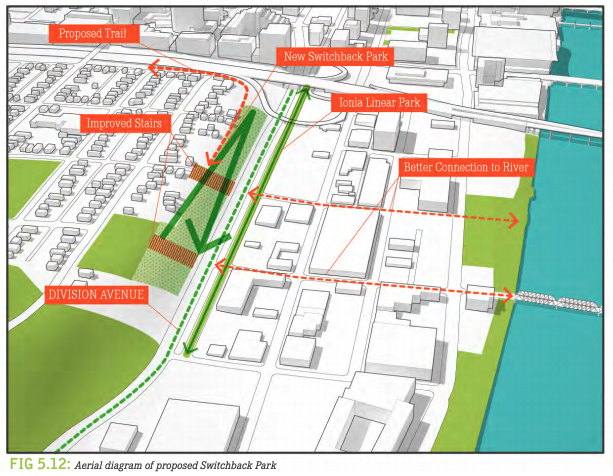 |
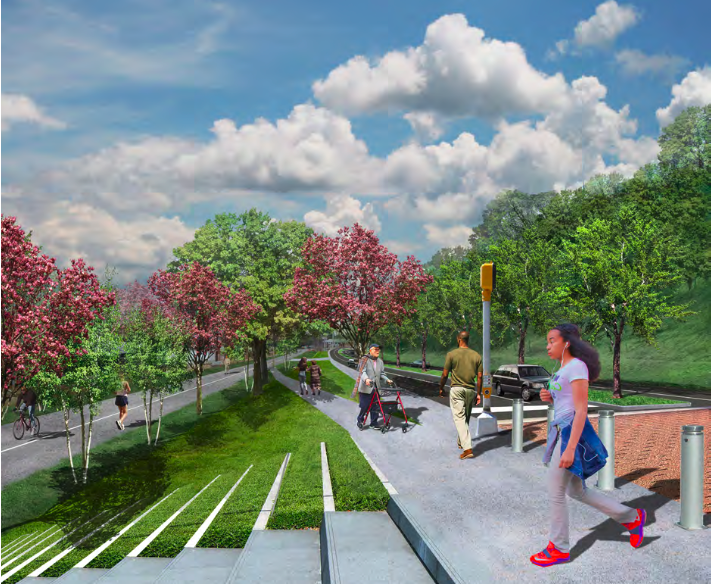 |
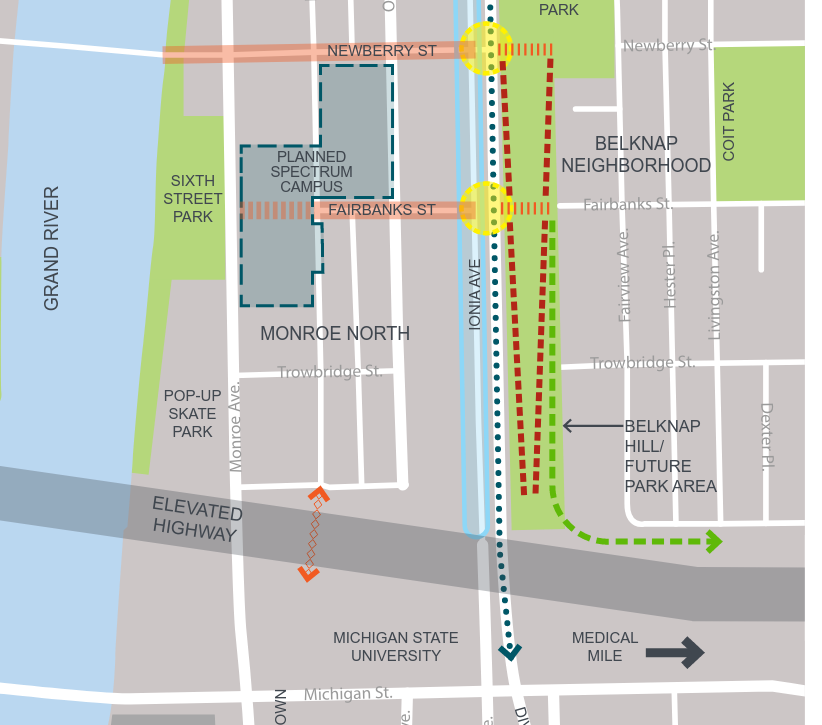 |
If you would like to help Strongtowns GR speak against this urban planning tragedy see 👉here👈 for a sample letter and who to send it to. We can build a better city than this.
RELATED:
- Planning commission tables Corewell Health request to demolish 5 buildings for parking lots, Crains 2023-10-26
- ‘This request is extreme.’ Corewell Health proposal to demolish buildings for parking lots tabled, Mlive 2023-10-26
563 Jefferson Ave SE
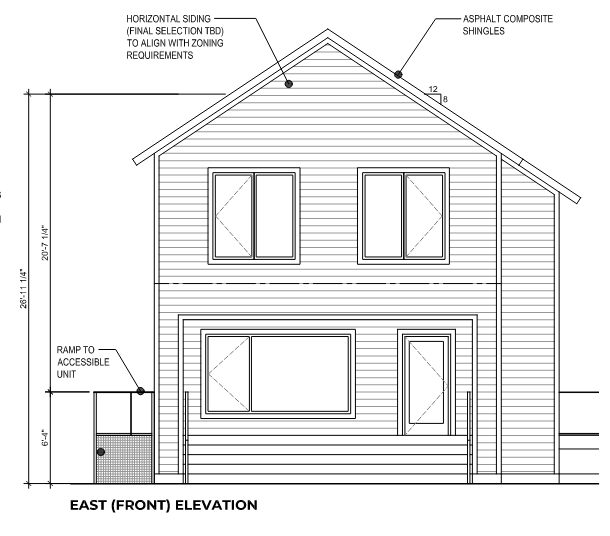 This item is a request for Special Land Use in order to construct a ~2,400sq/ft two story residential structure on a vacant lot. Why does this modest development require Special Land Use, and thus a hearing before the Planning Commission? Because it is not a 😇Single Family Home😇; this deceptively modest development would contain two units! It is a duplex. Anything other than a 😇Single Family Home😇 requires special dispensation from the city in order to protect "neighborhood stability" ... or something. If this were a 😇Single Family Home😇 the structure could squat across 60% of the lot and be 2.5 stories (35ft) tall with no public hearing.
This item is a request for Special Land Use in order to construct a ~2,400sq/ft two story residential structure on a vacant lot. Why does this modest development require Special Land Use, and thus a hearing before the Planning Commission? Because it is not a 😇Single Family Home😇; this deceptively modest development would contain two units! It is a duplex. Anything other than a 😇Single Family Home😇 requires special dispensation from the city in order to protect "neighborhood stability" ... or something. If this were a 😇Single Family Home😇 the structure could squat across 60% of the lot and be 2.5 stories (35ft) tall with no public hearing.
And people wonder why we have a housing shortage?
Here is the aerial view, one can see how this might impact the consistent neighborhood character:
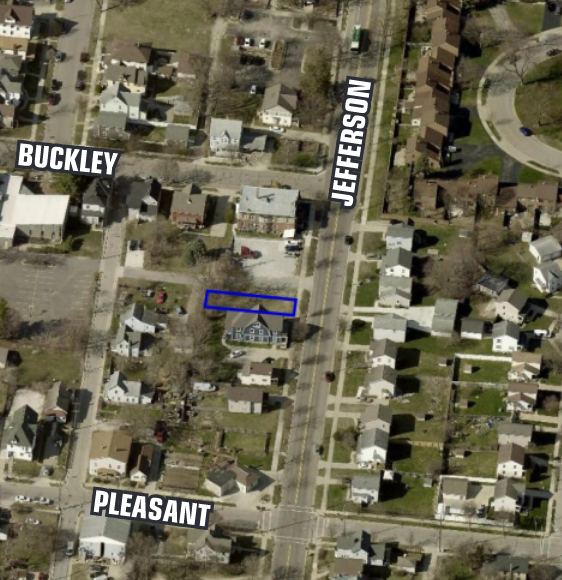 |
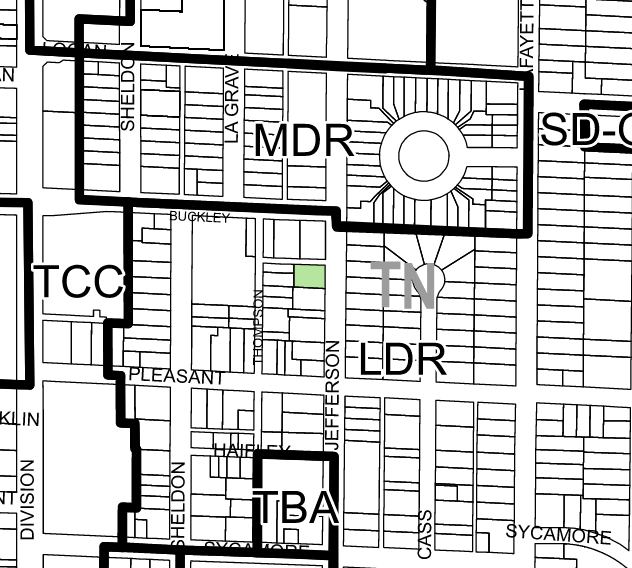 |
In this zone 1.5 parking spaces are required per unit, this development - with its two units - having a parking minimum of three spaces. The project provides 4 (four) spaces. It is one of the few residential developments in some time to not require a parking minimum related waiver.
Potential Zoning Reforms
At the the end of the agenda is a return to the Zoning Reform conversation from the 👉September 28th Planning Commission meeting👈. If you did not read 👉the preamble for the agenda for that meeting👈 I'd recommend it to understand the context of this discussion. The first conversation (Sept. 28th) covered accesory dwelling units (ADUs) and occupant limits, this one covers even hotter topics: infill development and group living requirements. All of these topics intersect with parking minimums as without a reform of the current ordinance's arbitrary parking requirements no other reforms will amount to much of anything in practice.
Aside: As I always ask - what is the difference between a duplex and an house with an ADU? Or a duplex with an ADU and a triplex? I don't know; neither does anyone else, as there isn't one. Urban Planning likes to have as many categories as possible?
Parking Minimums
Consider reducing or eliminating parking requirements in TN Neighborhoods.
"TN" this case means "Traditional", a denotation in the current zoning ordinance for areas of the city which were principally built out prior to the second world war. The neighborhoods, having been built prior to zoning and the regulatory preference given to the automobile, are generally somewhat denser than MCN (mid-century areas). The TN areas of the city are also some of the most desirable neighborhoods as many people like to live in interesting and active places - and not so much among asphalt parking lots.
Currently a 😇Single Family Home😇 is required to have two (2) parking spaces, a duplex three (3) parking spaces, and any residential structure with three or more units must have 1.5 parking spaces per unit plus 0.25 spaces for every bedroom more than a second bedroom. Thus a quadplex (4 units) of three one bedroom units and one three bedroom unit must have (1.54)+(1.0.25) = 6.25 parking spaces.
Some of the ideas proposed for consideration are: - "reduce or eliminate parking requirements for residential developments containing 6 or fewer units." - "Increase waiver distance for transit from 300ft to 0.5 mile (BRT) and 100ft to 0.25 mile (regular stop)"
The second point relates to the ability of developments to use the proximity to a public transportation stop to eliminate 50% of their parking requirement. The current ordinance's limit of 100ft is particularly ludicrous; that is not the length of a single block.
Aside: we will lay aside for the moment any debate of whether Grand Rapids has any BRT stops.
The point is clearly made that:
Failure to reduce or eliminate parking will negate the other proposed changes or necessitate acquisition of adjacent parcels and demolition of existing structures.
Yep.
Group Living Requirements
Single Room Occupancy homes (SROs) were a staple of American life and cities for generations. It is very likely that everyone reading this had grand parents and great grand parents who spent some period of their life living in an SRO. After the second world war America's ruling class decided the best approach to dealing with poor people was to displace them. SROs were outlawed across the nation. Where were people to go? Meh. They did not care.
Both the history and variety of SROs is fascinating. SROs provided a bottom wrung to the economic ladder; a safe and affordable first stop on the American Dream. Cities without SROs are cities where only those with the resources to jump straight to the second or third step can reap all the advantages of urban living.
- When America's Basic Housing Unit Was a Bed, Not a House, Bloomberg 2018-02-22
- The Hotel-Spirit, Slate 2022-07-17
- When No Landlord Will Rent to You, Where Do You Go?, NYT 2021-05-20
- SRO Housing, Nearly Zoned Out of Existence, Could Re-Emerge, Governing 2022-06-08
SROs come in a variety of types, and the city has the power to regulate those types distinctly. SROs range from market-rate room-for-rent residences to transitional shelters. Room-for-rent SROs are often referred to as "rooming houses" or "boarding houses".
Technically one can operate a room-for-rent SRO under the current ordinance with Special Land Use . . . good luck!. Several groups have tried. There are still those parking requirements; you need a huge lot. Huge lots within the TN areas of the city?
Some of the ideas proposed for consideration are:
- "Distinguish between small-, medium- and large-scale Group Living Uses"
- "Create tiered review process depending on the proposed number of residents"
- "Allow within LDR districts", presumably by-right. ???
- "Increase tenancy period" - which is how long people are allowed to stay; this is in reference to transitional shelters where currently a tenant at such a facility is only permitted to reside there for some number of months.
As you may be able to tell I have strong feelings about SROs - I recommend you read about them to understand why. ANYONE talking about housing, equity, affordability - - - all the Progressive buzz-words - - - who does not support the return of SROs as a vital component of American cities is not taking those topics seriously.
Infill Development (Missing Middle)
"Missing Middle" is a term for housing in between the duplex (or house+ADU) and the apartment building (whatever that means). It is something between two (2) and ~12 units. The upper end of the Middle is only vaguely defined. The important aspect of the Missing Middle is America stopped building it. This leaves American cities without a diversity of housing choices or a natural way for neighborhoods to evolve.
Aside: This problem is on purpose. The entire point of American Urban Planning has been to arrest evolution. The consequence of such an endevour is well understood my any JRR Tolkien fan. Preservation, inevitably, is decline. The world goes forward.
The current zoning ordinance inhibits the development of Missing Middle residential in myriad ways. First: parking requirements. Then set-backs, lot sizes, height limits, and process [Special Land Use for everything]. Building in a traditional neighborhood with small lots, alleys, and adjacent buildings is already challenging without a bureaucrat trying to come up with new challenges.
So, what's on the table:
- Spitting up the categories [yes, more categories]. Two (2) units, 3 - 6 units, and 7+ units?
- Pair by-right of up to 6 units on Link Residential and Network Residential streets.
- Eliminate lot widths requirements for developments up to 6 units.
- Eliminate parking requirements.
If you aren't familiar with the terms "Link Residential" or "Network Residential" these are categories of streets defined by the Grand Rapids' 👉Vital Streets👈 program. Every street in the city was categorized in 2016 and the City Commission adopted those categories in an effort to have a more consistent approach to transportation and land-use. As with most of the plans from the last decade there hasn't been much in the way of follow-through. The notion of linking development to Vital Streets categories was an idea that was raised in the 2018 Housing NOW efforts, at the time those conversations were squelched by the City Commission. It is encouraging to see this idea back again.
The document 👉here👈 contains a map of street categories and their definitions.
